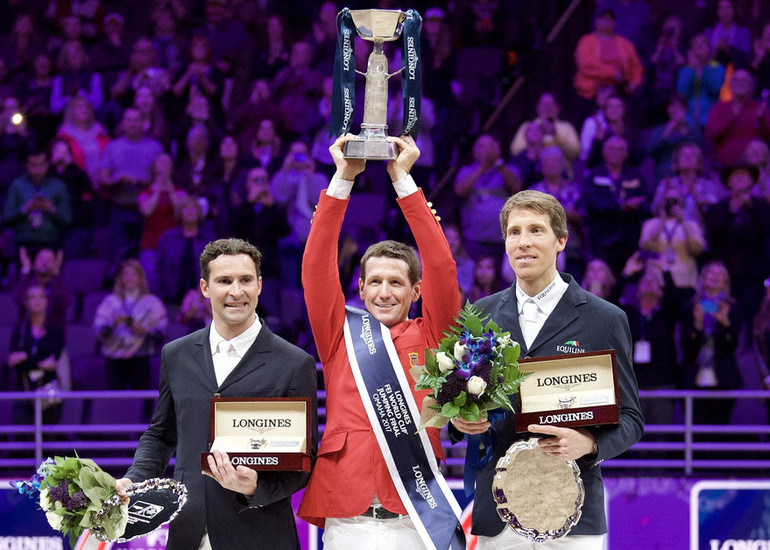Background
On Sunday 15th of April a new World Cup Champion will be crowned as the 2018 Longines FEI World Cup Final is staged in Paris (FRA). A total of 39 riders from 19 countries will line up for this year's final, at the AccorHotels Arena in the French capital.
Historical champions
Some of the biggest and most memorable partnerships in the sport has won the World Cup title: Ian Millar and Big Ben from Canada, Britain’s John Whitaker and Milton, Brazil’s Rodrigo Pessoa and Baloubet du Rouet and Germany’s Meredith Michaels-Beerbaum and Shutterfly are just a few of the legends whose names are linked to the prestigious title.
Four riders have claimed the FEI World Cup-title on three occasions:
Austria's Hugo Simon, winner of the inaugural final in Gothenburg with Gladstone, went on to record a back-to-back double of victories with ET FRH in 1996 and 1997.
Germany's Meredith Michaels-Beerbaum was also a three-time winner with Shutterfly: In Las Vegas in 2005, Gothenburg in 2008 and again in Las Vegas in 2009.
Brazil's Rodrigo Pessoa and the stallion Baloubet du Rouet hold the record as the only horse-and-rider partnership to post three back-to-back wins. They came out on top in 1999, 2000 and 2001.
Germany's Marcus Ehning won in Las Vegas in 2003, in Kuala Lumpur in 2006 and in Geneva in 2010 – and this year Ehning gets the chance to become historical again if he wins and becomes the first four-time World Cup Champion.
Concept and rules
The final is ridden over competitions held Thursday 12th of April, Friday 13th of April and Sunday 15th of April. The first part of the final, will be a Table C class ridden over a course set at a maximum of 1.60 meters. On Saturday, the riders will compete in a Table A class set at 1.50-1.60 meters with a jump-off. Riders who are eliminated or who retire in the first competition are not permitted to take part.
In the first two competitions points are given to all riders having finished the initial round. The winner of each competition gets one point more than the number of starters in the first final competition. The second placed gets two points less than the winner, the third placed three points less than the winner, and so on.
Riders who have been eliminated or have retired in the initial round of the first two competitions do not get points. Points won by riders who are tied are added up and divided equally. Fractions of 0.5 and more are rounded up; fractions of less than 0.5 are rounded down.
After the second competition, points are transformed into penalties. The rider with the highest number of points after two competitions will have 0 penalties. For all other riders the number of penalties will be calculated by multiplying with the coefficient of 0.50 the difference between their number of points and the points of the leading rider after two competitions.
The third and final competition takes place on Sunday. It will be a Table A class with two rounds over a Grand Prix course at 1.50-1.60 meters. The two rounds are approximately equal in the number of obstacles and length of the course, the second round having an increased level of difficulty. The 30 best placed riders (plus ties) from the provisional classification following the second competition are allowed to compete in the first round of the third competition.
Eligible for the second round of the third competition are the 20 best placed riders (plus ties) from the provisional classification following the first round. Riders with a clear score in the first round are allowed to start in the second round, even if their total score does not bring them into the top 20 riders (plus ties). However, they will compete only for the classification and prize money of the competition itself, and their score in the second round will not be taken into consideration when calculating their position in the final overall ranking of the final.
The winner of the Longines FEI World Cup Final 2018 is the rider that after all rounds has the least amount of penalties. If two or more riders should have the same amount of penalties, there will be a jump-off for the victory.
The Longines FEI World Cup Final in links:
Here are the links you need to follow the Longines FEI World Cup Final:
The riders and horses for the 2018 Longines FEI World Cup Final
The program for the 2018 Longines FEI World Cup Final
The results from the 2018 Longines FEI World Cup Final
The schedule for the live streaming of the competitions on FEI TV
The FEI info page on World Cup Jumping
Text © World of Showjumping // Source www.fei.org // Picture © Jenny Abrahamsson









